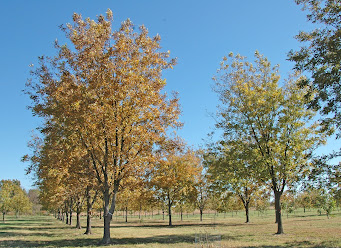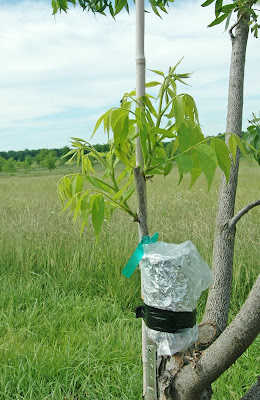25 April 2020, Bark graft set
This year, I decided to photograph the growth and training of one bark graft that I made this Spring. I'll be adding to this post as the season progresses so you can see every step I take in training the scion and pruning back the under-stock. The process began this year with a bark graft placed on a young tree on April 25th (photo at right).
17 May 2020, Bud swell
Three weeks after grafting, buds on the scion start to swell and green up (photo at right). This is a good sign for graft success. However, remember that there is often enough stored energy within the scion itself to push buds open even if the scion and stock haven't made a strong, growing connection. It is only when I see leaves expanding, do I known the scion and stock have united fully.
25 May 2020, Leaf Expansion
Four weeks after grafting, leaves are expanding on the new shoots growing from the scion (photo at right). At this point I am confident I have a successful graft.
1 June 2020, Shoot elongation
With warm summer temperatures, the new shoots growing from the scion start elongating rapidly (photo at right). Successful bark grafts usually grow 4-6 feet in height during the growing season.
 8 June 2020, Graft training
8 June 2020, Graft training
By the first week in June the graft has grown to a point where it is time to select one shoot to become the new central leader. In the photo at right, you can see that the scion has developed two strongly-growing shoots that are competing for dominance.
At this point, I will begin the tree training process to promote the growth of the scion, limit the scion to a single growing shoot (new central leader), and install a larger tree-training stake. These steps are illustrated in the photos below.
 |
| Prune back growth below the graft to push scion growth, June 8th |
 |
| Prune to one scion shoot, trim off top stub to promote healing. June 8th. |
 |
| Remove tape to prevent girdling, June 8th. |
 |
| Install 1 x 2 training stake, tie new growth with flagging tape to prevent wind damage. June 8th. |
 |
| Scion 2 feet tall on 15 June 2020 |
15 June 2020, Remove stalked buds
With all the tree's energy focused on a single shoot growth rate is rapid. At this point, the scion shoot is nearly 2 feet in length. However, rapid shoot growth promotes the formation of
stalked buds which lead to the formation of poorly attached lateral branches. My goal
in training this scion is to maintain a single, branch-less shoot during this first year of
growth. I remove all stalked buds on the scion shoot as they appear during the summer months. The photos below illustrate the appearance and removal of stalked buds.
 |
| Stalked buds form on rapidly growing scion (red arrows), 15 June 2020 |
 |
|
 |
| Scion shoot nearly 3 feet tall on 1 July 2020 |
1 July 2020, More tree training
By the 1st of July, the scion shoot is nearly 3 feet tall. New, upright-growing shoots have sprouted from the lower support limbs that can compete with the scion for light and nutrients. To maintain the tree's focus on growing the scion, I will prune off all upright-growing shoots competing with the scion and prune back the support limbs. To further train the scion shoot, I remove all newly-formed stalked buds and tie the new growth to the training stake. These steps are illustrated below.
 |
| Remove newly developed stalked buds from the upper portion on scion shoot. 1 July 2020. |
 |
| Remove all new shoots that are competing with scion. 1 July 2020. |
|
 |
| Prune back support limbs to encourage more scion growth. 1 July 2020. |
 |
| 3 August 2020 scion shoot is now 5 feet tall |
3 August 2020, Graft union painting and tree training
During early August, I like to remove all the wrappings that cover the graft union and paint that area with white latex paint. By removing the plastic bag and aluminum foil, I can clean out any ant nests that have formed under the protection of the plastic. I use white paint for two reasons. First, to prevent sun-scald on a portion of the tree that has been covered since late April. And second, to mark the site of the graft union for easy identification for years to come.
While I was attending to the graft union, I also pruned off any and all lateral shoots on the scion that have developed from stalked buds. I also made just a few pruning cuts to the support limbs to remove low hanging branches. At this point in the season, I limit the pruning back of the support limbs to allow the scion shoot to start slowing down its growth rate. I don't want rapid growth to continue into the fall because that can lead to winter injury of the scion.
 |
| All coverings removed from the bark graft. |
 |
| Graft union painted white |
 |
| Lateral shoots growing from primary buds on the lowest portion of the scion shoot will be removed |
 |
| Stalked buds have developed and sprouted on the upper portion of the scion. These will all be removed. |
 |
| Bark grafted tree before and after painting and training |






















































